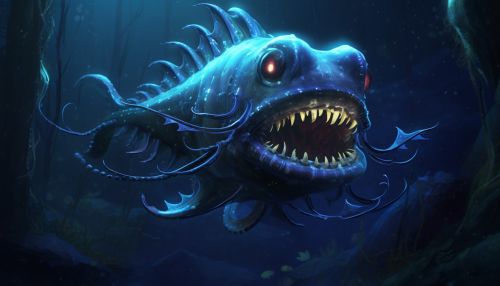Anglerfish
Introduction
The Anglerfish is a deep-sea fish known for its unique method of predation. Its name is derived from its distinctive method of 'angling' its prey. This fish is characterized by sexual dimorphism, where females are typically larger and are the ones that possess the iconic bioluminescent lure.
Taxonomy and Evolution
The anglerfish are part of the order Lophiiformes, which comprises five suborders, 16 families, and about 322 species. The evolution of the anglerfish has been a subject of interest due to its unique characteristics, particularly its bioluminescent lure and extreme sexual dimorphism. The anglerfish's evolutionary history is thought to have been influenced by the extreme conditions of the deep sea.
Physical Characteristics
Anglerfish vary greatly in size, from 2 centimeters to over a meter in length. The most distinctive characteristic of the anglerfish is the bioluminescent lure, known as the esca, which is used to attract prey. This lure is created by symbiotic bacteria that are housed in the esca. The bacteria generate light through a chemical reaction known as bioluminescence.


Habitat and Distribution
Anglerfish are found in all oceans of the world, but they are most common in the Atlantic and Antarctic Oceans. They inhabit the deep sea, typically at depths between 1000 and 4000 meters. The deep-sea environment is characterized by complete darkness, high pressure, and low temperatures, conditions that have led to the evolution of the anglerfish's unique adaptations.
Diet and Predation
The diet of the anglerfish primarily consists of fish and various types of cephalopods. The anglerfish is a sit-and-wait predator, using its bioluminescent lure to attract prey. Once the prey is within reach, the anglerfish uses its large, sharp teeth to secure the prey.
Reproduction and Life Cycle
The reproductive process of the anglerfish is unique and involves a process known as sexual parasitism. The much smaller male anglerfish attaches itself to the female, eventually fusing with her and relying on her for nutrients. The female can carry multiple males on her body, which ensures that she has a ready supply of sperm for fertilization.
Conservation Status
Most species of anglerfish are not considered threatened due to their deep-sea habitat, which protects them from many human activities. However, deep-sea fishing and climate change could potentially impact anglerfish populations in the future.
